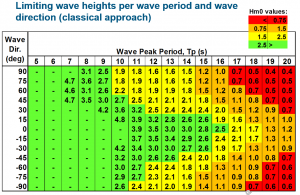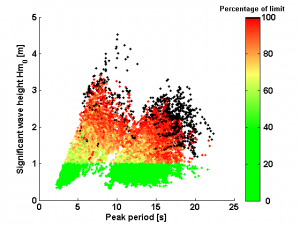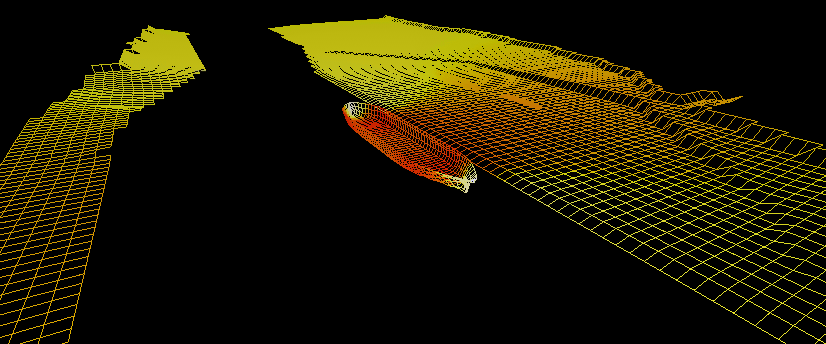Aktis DMA: Dynamic Mooring Analysis
Aktis Hydraulics we have a variety of Mooring Software Analysis packages at our disposal, each with their own strengths and capabilities. Our specialists can create an accurate and detailed mooring analysis for various stages of design and for a broad range of applications, including offshore moorings, terminal operability assessments and multi-body operations. The software used at Aktis include OrcaFlex, SHIP-Moorings, Aktis DMA and OPTIMOOR as well as hydrodynamic packages ANSYS-AQWA and OrcaWave. For full details on our models, please navigate through the drop-down menu below.
Aktis has thereby THE tools in hand to simulate the beneficial effects of innovative mooring systems such as the ShoreTension® and DynaMoorTM systems. Also, the effect of a RoRo or RoPax ramp tended on the quay can be addressed efficiently.
Our in-house developped model Aktis DMA is our main tool because of it’s versatility and efficiency. This is something also being recognised by BMT West Australia and IMDC (Belgium) who have the software in use under license.
In addition, the team of Aktis provide SHIP-Moorings modelling support to Arcadis and Witteveen+Bos (both The Netherlands), DYP Ingeniera and SiportXXI (Spain (both Spain), and Nanjing Hydraulic Institute (China).
Aktis DMA
The team of Aktis Hydraulics have developped Aktis Dynamic Mooring Analysis. The model is a fully validated time-domain mooring analysis (DMA) software. Aktis DMA accounts for the following features:
- The frequency dependent hydrodynamic response properties of the moored vessel (derived
using ANSYS AQWA-LINE) transferred to the time domain using the Convolution Integral
Method (Cummins, 1962) for time varying radiated wave damping. - First-order and second-order (slowly varying drift) including mean drift wave forces. This
intrinsically includes the wave shielding or other interaction effects by nearby vessels. - Wave schematisation including various spectral shapes and directional spreading (2D or 3D
wave spectra) and application of multiple wave systems (e.g. wind waves and swell from different
directions). - Hull-flow interaction forces (OCIMF);
- Time varying wind forces, including directional variability for industry standard wind spectra (API;
NPD and other), also accounting for wind shielding by close-by objects; wind coefficient from
OCIMF/SIGGTO; - Non-linear mooring lines (enabling wires equipped with tails) and fender forces;
- Viscous damping terms for roll and yaw motions;
- Six degrees of freedom (or Nx6 for N interacting bodies) response by properly accounting for the
radiated wave forces and coupling of e.g. wind induced roll motions transferred into sway
motions by the fendering system. - Time-domain evaluation of innovative mooring systems such as Cavotech Mooring Master and the KRVE ShoreTension.
DMA output consists of time-series of all basic vessel motions (surge, sway, heave, roll, pitch, yaw), related velocities and accelerations and motions at specific locations (e.g. manifold) if needed. For STS operations also relative motions between the vessels can be output. Other output includes all mooring loads (mooring lines, hooks/bollards, fenders) and elongations/deflections. The output can be statistically and spectrally analysed.
ANSYS-AQWA
At Aktis Hydraulics we wield Ansys-AQWA for most of our hydrodynamic response assessments. In particular we make use of AQWA-LINE to support our motion response evaluations and the aforementioned DMA and Orcaflex analysis. We typically apply Ansys-AQWA-NAUT in those events that the hydrodynamic loads are impacted by non-linear wave behaviour such as parametric rolling, tsunami impacts and air-gap evaluations.

Orcaflex
Orcaflex is the world’s leading package for the dynamic analysis of offshore marine systems, renowned for its breadth of technical capability and user friendliness. Aktis Hydraulics applies Orcaflex for more complex mooring patterns such as spread mooring systems and single point moorings, including
- multiple catenary components;
- clump-weights
- seabed variability influencing chain lengths and anchor positions
- swepth path analysis of a weathervaning system
- mooring design and load evaluation
The strengths of Orcaflex compared to our DMA is that it allows for a better representation of large motions where the catenary and buoy are significant component influencing the overall performance of the system.
Optimoor
Aktis Hydraulics has worked together with Tension Tech International to enhance the Optimoor Dynamic Wave Response module. The cooperation with TTI is continuing and the role of Aktis to make Optimoor suited to treat first- and second-order wave loads in the time domain.
Optimoor is currently ideal for making mooring layouts and to get a first indication of critical elements in the mooring system. Optimoor is used as a first-pass design tool for layout testing. Typically, after an Optimoor eveluation the full environmentall climate is being tested in Aktis DMA to account for
- non-linear interactions between motion cross-over interactions like sway induced roll (important for manifold motions)
- wind induced heel
- discontinuous fender contact
- non-linear motion response like sub-harmonic oscillation
- Full 6 degrees of freedom.
The above features are not included in Optimoor or are compromised.

classical approach: ‘binned metocean conditions’

NEW – DMA hindcast
evaluation of all historic events
(+39 years)


